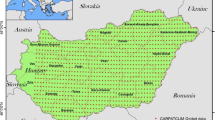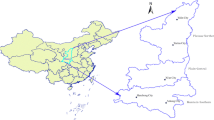Abstract
This study reveals the impacts of climatic variable trends on drought severity in Xinjiang, China. Four drought indices, including the self-calibrating Palmer drought severity index (sc-PDSI), Erinç’s index (I m), Sahin’s index (I sh), and UNEP aridity index (AI), were used to compare drought severity. The ensemble empirical mode decomposition and the modified Mann-Kendall trend test were applied to analyze the nonlinear components and trends of the climatic variable and drought indices. Four and six climatic scenarios were generated in sc-PDSI, I m, I sh, and AI with different combinations of the observed and detrended climatic variables, respectively. In Xinjiang, generally increasing trends in minimal, average, and maximal air temperature (T min, T ave, T max) and precipitation (P) were found, whereas a decreasing trend in wind speed at 2 m height (U 2) was observed. There were significantly increasing trends in all of the four studied drought indices. Drought relief was more obvious in northern Xinjiang than in southern Xinjiang. The strong influences of increased P on drought relief and the weak influences of increased T min, T ave, and T max on drought aggravation were shown by comparing four drought indices under different climate scenarios. Decreased U 2 had a weak influence on drought, as shown by the AI in different climate scenarios. The weak influences of T and U 2 were considered to be masked by the strong influences of P on droughts. Droughts were expected to be more severe if P did not increase, but were likely milder without an increase in air temperature and with a decrease in U 2.









Similar content being viewed by others
References
Allen RG, Pereira LS, Raes D, Smith M (1998) Crop evapotranspiration: guidelines for computing crop requirements. Irrigation and Drainage Paper 56. Roma, Italia: FAO
Arora VK (2002) The use of the aridity index to assess climate change effect on annual runoff. J Hydrol 265(1–4):164–177
Budyko MI (1974) Climate and life. Academic Press, Orlando, FL, 508 pp
Chen Y, Deng H, Li B, Li Z, Xu C (2014) Abrupt change of temperature and precipitation extremes in the arid region of Northwest China. Quat Int 336:35–43
CMA (2006) Classification of meteorological drought. GB/T 20481-2006. China Meteorological Press, Beijing In Chinese
Dai A (2013) Increasing drought under global warming in observations and models. Nat Clim Chang 3:52–59. doi:10.1038/NCLIMATE1633
Dai A, Trenberth KE, Qian TT (2004) A global dataset of Palmer drought severity index for 1870-2002: relationship with soil moisture and effects of surface warming. J Hydrometeorol 5(6):1117–1130
Erinç S (1965) An attempt on precipitation efficiency and a new index. Istanbul University Institute Release.Baha Press,, Istanbul (in Turkish)
Evans JP (2008) Changes in water vapor transport and the production of precipitation in the Eastern Fertile Crescent as a result of global warming. J Hydrometeorol 9(6):1390–1401
Fu C, De Vries FP (2006) The initial science plan of the monsoon Asia integrated regional study. Meteorology Press 80 p
Geng Q, Wu P, Zhao X, Wang Y (2014) Comparison of classification methods for the divisions of wet/dry climate regions in Northwest China. Int J Climatol 34:2163–2174
Gill AE (1982) Atmosphere–ocean dynamics. Academic Press, New York
Hamed KH, Rao RA (1998) A modified Mann-Kendall trend test for autocorrelated data. J Hydrol 204:182–196
Hu Q, Willson GD (2000) Effects of temperature anomalies on the Palmer drought severity index in the central United States. Int J Climatol 20(15):1899–1911
IPCC (Intergovernmental Panel on Climate Change) (2007) Summary for policymakers. In: Climate change 2007: synthesis report. Contribution of Working Groups I, II and III to the Fourth Assessment Report of the Intergovernmental Panel on Climate Change. Cambridge University Press, London
Ji F, Wu ZH, Huang JP, Chassignet EP (2014) Evolution of land surface air temperature trend. Nat Clim Chang 4(6):462–466
Jiang F, Zhu C, Mu G (2002) Enlargement of flood and drought disasters in Xinjiang. Acta Geograph Sin 52:57–66 (in Chinese)
Kendall MG (1975) Rank auto-correlation methods. Charles Griffin, London
Kutiel H, Türkes (2005) New evidences for the role of the North Sea–Caspian pattern on the temperature and precipitation regimes in continental central Turkey. Geogr Ann 87A(4):501–513
Koutroulis AG, Vrohidou AK, Tsanis IK (2011) Spatiotemporal characteristics of meteorological drought for the Island of Crete. J Hydrometeorol 12(2):206–226
Li Y, Zhou MD (2014) Trends of dryness index based on potential evapotranspiration and precipitation over 1961-2099 in Xinjiang, China. Adv Meteorol. doi:10.1155/2014/548230
Li Y, Horton R, Ren T, Chen C (2010) Prediction of annual reference evapotranspiration using climatic data. Agric Water Manag 97(2):300–308
Liu WW, An SQ, Liu GS, Guo AH (2004) The farther modification of Palmer drought severity model. J Appl Meteorol Sci 15(2):207–216 (in Chinese)
Mann HB (1945) Non-parametric tests against trend. Econometrica 13:245–259
McKee TB, Doeskin NJ, Kleist J (1993) The relationship of drought frequency and duration to time scales. In: Proceedings of the 8th Conference on Applied Climatology, January 17–22, Anaheim, CA, Am. Meteor. Soc., 179–184
Núñez J, Rivera D, Oyarzún R, Arumí JL (2014) On the use of standardized drought indices under decadal climate variability: critical assessment and drought policy implications. J Hydrol 517:458–470
Osborn TJ, Jones PD (2014) The CRUTEM4 land-surface air temperature data set: construction, previous versions and dissemination via Google Earth. Earth Syst Sci Data 6:61–68
Otkin JA, Anderson MC, Hain C, Svoboda M (2014) Examining the relationship between drought development and rapid changes in the evaporative stress index. J Hydrometeorol 15:938–956. doi:10.1175/JHM-D-13-0110.1
Palmer WC (1965) Meteorological drought: U.S. Weather Bureau Research Paper, 45, 64 p
Palmer WC (1968) Keeping track of crop moisture conditions, nationwide: the new crop moisture index. Weatherwise 21:156–161
Qian C, Yan ZW, Fu CB (2012) Climatic changes in the twenty-four solar terms during 1960-2008. Chin Sci Bull 57(2–3):276–286
Qian C, Zhou T (2014) Multidecadal variability of North China aridity and its relationship to PDO during 1900-2010. J Clim 27(3):1210–1222
Sahin S (2012) An aridity index defined by precipitation and specific humidity. J Hydrol 444-445:166–208
Sahin S, Cigizoglu HK (2013) The effect of the relative humidity and the specific humidity on the determination of the climate regions in Turkey. Theor Appl Climatol 112:469–481. doi:10.1007/s00704-012-0743-6
Sen PK (1968) Estimates of the regression coefficient based on Kendall’s tau. J Am Stat Assoc 63:1379–1389
Shi YF, Shen YP, Kang ES, Li DL, Ding YJ, Zhang GW, Hu RJ (2007) Recent and future climate change in northwest China. Clim Chang 80:379–393
Song X, Li L, Fu G, Li J, Zhang A, Liu W, Zhang K (2013) Spatial–temporal variations of spring drought based on spring-composite index values for the Songnen Plain, Northeast China. Theor Appl Climatol. doi:10.1007/s00704-013-0957-2
Sun C, Ma Y (2015) Effects of non-linear temperature and precipitation trends on Loess Plateau droughts. Quat Int. doi:10.1016/j.quaint.2015.01.051
Topaloglu F (2006) Regional trend detection of Turkish river flows. Nord Hydrol 37(2):165–182
UNEP (1993) World atlas of desertification. The United Nations Environment Programme (UNEP), London
Vicente-Serrano SM, Beguería S, JI L-M (2010) A multiscalar drought index sensitive to global warming: the standardized precipitation evapotranspiration index. J Clim 23:1696–1718
Wang B, Zhang M, Wei J, Wang S, Li S, Ma Q, Li X, Pan S (2013) Changes in extreme events of temperature and precipitation over Xinjiang, northwest China, during 1960-2009. Quat Int 298:141–151
Wang YH, Yeh CH, Young HWV, Hu K, Lo MT (2014) On the computational complexity of the empirical mode decomposition algorithm. Physica A 400:159–167
Wells N, Goddard S, Hayes MJ (2004) A self-calibrating Palmer drought severity index. J Clim 17(12):2335–2351
Wen KG, Shi YG (2006) China’s meteorological disaster: volume of Xinjiang. China Meteorological Press, Beijing 340p (in Chinese)
Wu ZH, Huang NE (2009) Ensemble empirical mode decomposition: a noise-assistant data analysis method. Advan Adapt Data Ana 1(1):1–41
Wu ZH, Huang NE, Chen XY (2009) The multi-dimensional ensemble empirical mode decomposition method. Advan Adapt Data Anal 1(3):339–372
Wu ZH, Huang NE, Long SR, Peng CK (2007) On the trend, detrending, and variability of nonlinear and nonstationary time series. Proc Natl Acad Sci U S A 104(38):14889–14894
Xu C, Li J, Zhao J, Gao S, Chen Y (2015) Climate variations in northern Xinjiang of China over the past 50 years under global warming. Quat Int 358:83–92
Yue S, Wang CY (2002) Regional streamflow trend detection with consideration of both temporal and spatial correlation. Int J Climatol 22:933–946
Yue S, Wang CY (2004) The Mann-Kendall test modified by effective sample size to detect trend in serially correlated hydrological series. Water Resour Manag 18:201–218
Zhang Q, Li JF, Singh VP, Bai YG (2012a) SPI-based evaluation of drought events in Xinjiang, China. Nat Hazards 64(1):481–492
Zhang Z, Xu C, Yong B, Hu J, Sun Z (2012b) Understanding the changing characteristics of droughts in Sudan and the corresponding components of the hydrologic cycle. J Hydrometeorol 13(5):1520–1535
Acknowledgments
This study is jointly supported by the Xinjiang Joint Project of China National Science Foundation (U1203182), China Scholarship Council for Studying Abroad (201506305014), and China 111 project (B12007). We also thank the Meteorological Data Sharing Service Network in China for supplying weather data. Dr. Zilefac E Asong helped in the revision processes. We thank the anonymous reviewers who gave us very constructive suggestions for improving the paper.
Author information
Authors and Affiliations
Corresponding authors
Rights and permissions
About this article
Cite this article
Li, Y., Sun, C. Impacts of the superimposed climate trends on droughts over 1961–2013 in Xinjiang, China. Theor Appl Climatol 129, 977–994 (2017). https://doi.org/10.1007/s00704-016-1822-x
Received:
Accepted:
Published:
Issue Date:
DOI: https://doi.org/10.1007/s00704-016-1822-x




